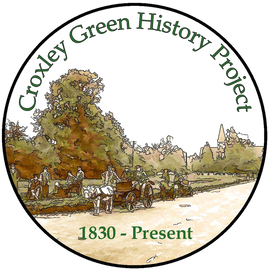Peggy Leader (nee Rogers)
Croxley - My Childhood Home - From The Croxley Green Resident issue 133
When I was born, in 1904, Croxley Green consisted of cottages at the lower end of New Road, and houses built by J. Dickinson's in the Square round what was then the Band Stand; where the Band played on Friday evenings. I think the Institute was there in the form of a corrugated iron building. One of my first recollections was seeing the women from the barges on the Canal come up for their shopping in their long black skirts and shawls. The Canal was very busy in those days, barges bringing wood pulp and coal to the Mill and transporting paper to Apsley Mills. At the lower end of the New Road there was a grocers owned by Mr. Wilbee of Sarratt, managed by Mr. Blake, two milkmen, (Mr. Forster and Mr. Syrett) and further up a Grocer's owned by Mr. Dimmock (later J. & S. David) and a Haberdashers where my mother had been apprenticed, later owned by Miss Patterson. When I was three years old, we moved into a house in the Square which I think was newly built by Dickinson's. I know the rent was 5/3d. per week and very nice houses they were with long gardens. In those days my father was a Papermaker, in fact, about that time my grandfather, uncles and aunt all worked for Dickinson's, and lived in the Square. In those days Croxley was Dickinson's and Dickinson's was Croxley with Mr. Barton-Smith, the Manager looking after everyone. Very good days they were too! I went to the Infants School in York Road - Miss Dickinson was the Head Mistress of the Infants and Miss Clarke the Senior Girls School Mistress. They Iived together in the School House at the corner of Yorke Road and Watford Road. Mr. Wilson was Senior Boys Master and he with Miss Rickets looked after the musical side of the village and Mr. Haynes, the school attendance officer, looked after the truants, and, in those days was much feared.
The Mills were worked on a 12-hour shift basis, 6 am - 6 pm. days and nights. There was little provision for food. The Day Shift took breakfast in their pockets, and at lunch time, boys and girls of 11-12 years, hurried out of school and collected baskets from the various houses containing enamel dishes with hot food. The baskets had a lid with skewered through loops to keep it closed and the lucky ones had a hot pasty or something to eat on the way (if they could carry it) - as most carried two
baskets and got, I think, 6p. a week. The village was a complete unit: Mr. Jackson and Mr. Saunders (butchers), Mr. Gibbs (blacksmith), Mr. Holloway, (baker), Mr. Ben Ward (Postmaster), Mr. Ellement (shoe-repaired and another Mr. Ellement (Grocer) on the corner of Yorke and New Road. I remember Mr. Holloway used to make long plum cakes for the Saturday cricket match at Durrants Farm.
All the Winter activities were held at the Institute and on the Green in the Summer where Miss Ricketts would teach us to "plait the Maypole". Celebrations were marked with a Procession along the Old Road and up the New Road. I remember my father decorating his bicycle like a ship with glass fairy lights each with a candle in it - the Revels are ingrained in Croxley's history.
One Spring treat was to walk to Loudwater with 10 a penny and watch Mr. Dorrofield cut one a bunch of watercress - asmuch as one could carry. In those days the Green was surrounded by Cherry Orchards and when the cherries were ripe, one Sunday, people would come from miles and sit on the Green, eating cherries and drinking beer. These orchards were mostly owned by Mr. Stone who had a Coal Merchants businessand who also owned one or two brakes (covered wagonettes). We used to go in these for all our school treats, mostly to Bricket Wood where there was a fair, and for many of us, that was the highlight of the year along with Dickinson's Children's Christmas Party at the Institute.
We always managed to have a week at the seaside, but in those days it meant walking to Watford Junction and carrying your luggage.I well remember Croxley l.M.S. Railway Station being built, and the night the Suffragettes burnt it down; just as it was completed.
We attended the Methodist Chapel in the New Road, opposite where Mr. Charlie Sears lived - a great local character. Mr. Grace was Choir Master and Mr. Dimmock ran the Sunday School. Mrs. Rookes was Organist and the families of Chater, Groom and Hedges were all in the various activities - I do not expect there are many of those
families left now. Of course, All Saint Church was always there, and in the early days, the Vicarage opposite, but in those days you were either "Church or Chapel" and it was in modern terms "a closed shop". One lady all the older generation will remember is Mrs. Tandy who, with Dr. Evans saw most of us into this world, and made the passing of many much easier.She lived in the Square and, although sometimes criticised, was the first person one sent for when in trouble.
Until the General Strike, I do not think anyone was ever out of work. No-one had a lot of money but between them, Dickinson's and Mr. Barton-Smith made sure no-one was in real want. That is why when the General Strike was called, everyone at the Mill was appalled that they were not supposed to work. A meeting was called at the Institute. The men voted to return to work and The Union of The House of Dickinson was formed, which looked after Pensioners etc. in a wonderful way - and, I think,
it is still operating in some form. In those days the Mill Hill was exceedingly rough and steep and I well remember my Aunty sliding down it on her bottom to get to work; crawling up on her hands and knees to come home. Such was the loyalty to Dickinson's in those happier days and such was life in my childhood.
When I was born, in 1904, Croxley Green consisted of cottages at the lower end of New Road, and houses built by J. Dickinson's in the Square round what was then the Band Stand; where the Band played on Friday evenings. I think the Institute was there in the form of a corrugated iron building. One of my first recollections was seeing the women from the barges on the Canal come up for their shopping in their long black skirts and shawls. The Canal was very busy in those days, barges bringing wood pulp and coal to the Mill and transporting paper to Apsley Mills. At the lower end of the New Road there was a grocers owned by Mr. Wilbee of Sarratt, managed by Mr. Blake, two milkmen, (Mr. Forster and Mr. Syrett) and further up a Grocer's owned by Mr. Dimmock (later J. & S. David) and a Haberdashers where my mother had been apprenticed, later owned by Miss Patterson. When I was three years old, we moved into a house in the Square which I think was newly built by Dickinson's. I know the rent was 5/3d. per week and very nice houses they were with long gardens. In those days my father was a Papermaker, in fact, about that time my grandfather, uncles and aunt all worked for Dickinson's, and lived in the Square. In those days Croxley was Dickinson's and Dickinson's was Croxley with Mr. Barton-Smith, the Manager looking after everyone. Very good days they were too! I went to the Infants School in York Road - Miss Dickinson was the Head Mistress of the Infants and Miss Clarke the Senior Girls School Mistress. They Iived together in the School House at the corner of Yorke Road and Watford Road. Mr. Wilson was Senior Boys Master and he with Miss Rickets looked after the musical side of the village and Mr. Haynes, the school attendance officer, looked after the truants, and, in those days was much feared.
The Mills were worked on a 12-hour shift basis, 6 am - 6 pm. days and nights. There was little provision for food. The Day Shift took breakfast in their pockets, and at lunch time, boys and girls of 11-12 years, hurried out of school and collected baskets from the various houses containing enamel dishes with hot food. The baskets had a lid with skewered through loops to keep it closed and the lucky ones had a hot pasty or something to eat on the way (if they could carry it) - as most carried two
baskets and got, I think, 6p. a week. The village was a complete unit: Mr. Jackson and Mr. Saunders (butchers), Mr. Gibbs (blacksmith), Mr. Holloway, (baker), Mr. Ben Ward (Postmaster), Mr. Ellement (shoe-repaired and another Mr. Ellement (Grocer) on the corner of Yorke and New Road. I remember Mr. Holloway used to make long plum cakes for the Saturday cricket match at Durrants Farm.
All the Winter activities were held at the Institute and on the Green in the Summer where Miss Ricketts would teach us to "plait the Maypole". Celebrations were marked with a Procession along the Old Road and up the New Road. I remember my father decorating his bicycle like a ship with glass fairy lights each with a candle in it - the Revels are ingrained in Croxley's history.
One Spring treat was to walk to Loudwater with 10 a penny and watch Mr. Dorrofield cut one a bunch of watercress - asmuch as one could carry. In those days the Green was surrounded by Cherry Orchards and when the cherries were ripe, one Sunday, people would come from miles and sit on the Green, eating cherries and drinking beer. These orchards were mostly owned by Mr. Stone who had a Coal Merchants businessand who also owned one or two brakes (covered wagonettes). We used to go in these for all our school treats, mostly to Bricket Wood where there was a fair, and for many of us, that was the highlight of the year along with Dickinson's Children's Christmas Party at the Institute.
We always managed to have a week at the seaside, but in those days it meant walking to Watford Junction and carrying your luggage.I well remember Croxley l.M.S. Railway Station being built, and the night the Suffragettes burnt it down; just as it was completed.
We attended the Methodist Chapel in the New Road, opposite where Mr. Charlie Sears lived - a great local character. Mr. Grace was Choir Master and Mr. Dimmock ran the Sunday School. Mrs. Rookes was Organist and the families of Chater, Groom and Hedges were all in the various activities - I do not expect there are many of those
families left now. Of course, All Saint Church was always there, and in the early days, the Vicarage opposite, but in those days you were either "Church or Chapel" and it was in modern terms "a closed shop". One lady all the older generation will remember is Mrs. Tandy who, with Dr. Evans saw most of us into this world, and made the passing of many much easier.She lived in the Square and, although sometimes criticised, was the first person one sent for when in trouble.
Until the General Strike, I do not think anyone was ever out of work. No-one had a lot of money but between them, Dickinson's and Mr. Barton-Smith made sure no-one was in real want. That is why when the General Strike was called, everyone at the Mill was appalled that they were not supposed to work. A meeting was called at the Institute. The men voted to return to work and The Union of The House of Dickinson was formed, which looked after Pensioners etc. in a wonderful way - and, I think,
it is still operating in some form. In those days the Mill Hill was exceedingly rough and steep and I well remember my Aunty sliding down it on her bottom to get to work; crawling up on her hands and knees to come home. Such was the loyalty to Dickinson's in those happier days and such was life in my childhood.


